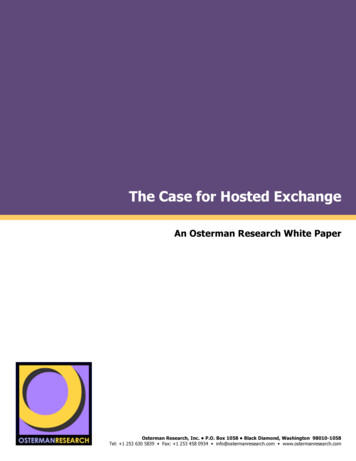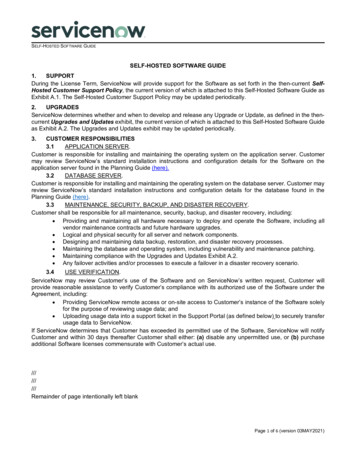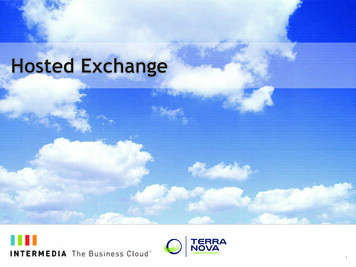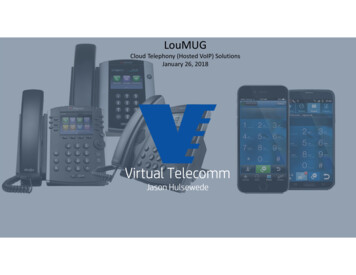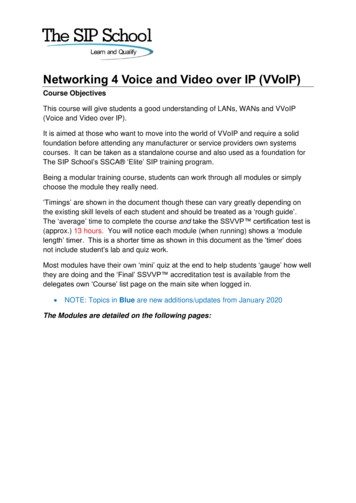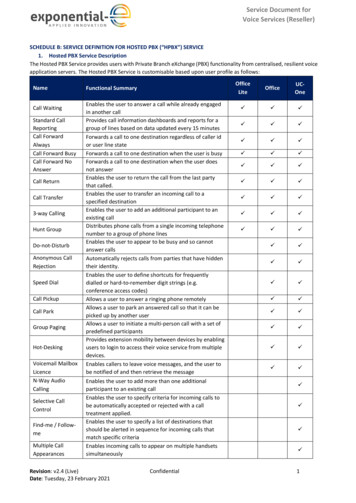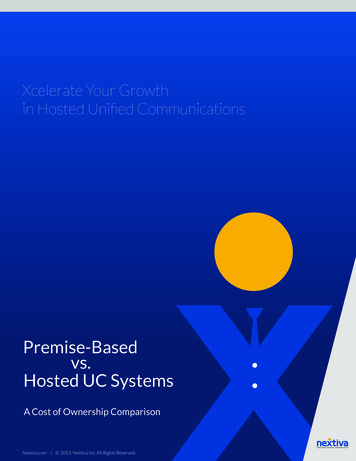
Transcription
Xcelerate Your Growthin Hosted Unified CommunicationsPremise-Basedvs.Hosted UC SystemsA Cost of Ownership ComparisonNextiva.com 2013. Nextiva Inc. All Rights Reserved.
Executive Summary: Seeing the Big Price PictureWith a lack of time and comparative information, business owners can struggle to make sound decisions onnew technology investments. You’re often left to compare the seemingly easiest factor initial capital cost.However, upfront costs rarely tell the whole story. That’s certainly true when comparing premise-based tohosted Unified Communications (UC) systems.On the surface, premise-based UC systems can appear to have the lower total cost of ownership (TCO).Buyers tend to start and stop comparing hosted systems to just the capital cost of a premise-based system,which is then depreciated over a five-year period. But a deeper dive reveals other factors associated withpremise-based systems that increase the whole lifecycle costs.Many premise-based systems have limitations in terms of scalability or functionality that only becomeapparent as users seek to add more advanced functionality. Common cost increases include the additionof mobility services, advanced messaging handling and system storage.Anecdotal stories from premise-based system users also cite numerous hidden costs that seriously impactedproductivity. In particular, businesses struggled with mobility integration and soft clients, as well as initializingfeatures like voicemail to email.This TCO guide brings clarity to decision-makers by comparing the actual costs and features of today’s hostedand premise-based UC systems. We will look at the following areas:1. System & capital costs2. Maintenance, management & support3. Installation4. Training5. Equipment housing & power6. IT staffingSystem and Capital CostsThe primary aspect of cost is the UC system price, which generally comprises of the base system cost of theunit, the phone cost, soft client costs and other user licensing costs. The majority of mid-market systems havea per seat cost of in excess of 500 today but buyers will be shocked to learn that overall opex costs candouble that figure every year!With many premise-based systems, capital costs can add greatly to the annual investment. For example,a typical smallscale system costing approximately 10,000 could have operational costs totaling 1,200per year—or over 30 percent of the total equipment costs—in a three-year period.1Smaller businesses considering a premise-based system need to understand the configuration model ofthe premise based system. Too often, businesses overload their systems with features often leading toan earlier than expected replacement of the system. For example adding call recording or enhancedvoice mail nearly always leads to a significant impact on system design and longevity. There can alsobe hidden costs around mobility features or soft clients. Businesses using Macs should be especiallycareful to check that they are supported by soft clients.Nextiva.com 2013. Nextiva Inc. All Rights Reserved.
For hosted systems, there are normally no system costs, and businesses can choose to rent or lease their handsets.Another advantage of a hosted system is that it typically includes between one and three user packs that provideflexibility in fitting user feature/cost requirements for your business.Capital costs for a 100- to500-seat premise-based UCsystem can increase to over 800 per user.Capital Costs / IPT PhoneCapital Costs per IPT Phone Based on Deployment SizeSource: Aberdeen Group, January 2012 1000 889 900 800 741 718 700 639 600 500 400 300 268 200 100 100 IPT Phonesn 52100-499IPT Phonesn 45500-999IPT Phonesn 201000-2500IPT Phonesn 15 2500IPT Phonesn 16Maintenance, Management and SupportMaintenance contract and software assurance costs for a premise-based UC system typically average between17 and 18 percent of the system’s value. In the case of smaller systems, the premise-based supplier will delivermaintenance and support under a single package.While a maintenance contract arrangement can dramatically lower costs, it will not lower them to the level ofa hosted system, which already includes maintenance costs.Resellers of premise-based systems have long created lucrative business models managing systems for the smallbusinesses. Typically the management contract will be around 5-10% of the system value every year. In somecases, the reseller does very little for this fee but external management of the system creates significant delays inmoves and changes. This management straight-jacket is a major driver behind why dynamic companies areselecting hosted systems.InstallationMany hosted systems are moving toward either partial or fully self-installed options, given the fact thata hosted system can be routed over a business’s broadband circuits already installed for other dataapplications. But this is rarely the case for premise-based systems.Premise-based solutions have to factor in either T1 or SIP trunking services to achieve an equivalent cost.As with the hosted solution, a SIP trunk would require a data bearer circuit in addition to the SIP trunkingservice itself.On average, the planning, infrastructure changes and phone/client configuration require between 1.62and 2.5 hours of installation services per user. The variance depends on the vendor and the degree ofexpertise involved. Using average labor costs, installation would run between 100 and 200 peruser—creating a major added expense.Nextiva.com 2013. Nextiva Inc. All Rights Reserved.
TrainingBringing a new system onboard means significant training overhead. Year one training costs for administratorswith a premise-based system typically total around 6,000 up front.Premise-based vendors also charge a refresh price of between 40 and 100 percent of year-one costs foradministrators to maintain their system knowledge. With a hosted UC system, training is normally bundled inthe installation price and are often delivered in web-based modules that users can view independently or in smallgroups. This increases productivity while reducing training costs.Equipment Housing and PowerFor smaller on-premise systems, equipment and power costs will be relatively minor. Depending on the numberof users supported in larger systems (1,000 seats), however, expenses can increase between 5,000 and 10,000a year. There are also costs associated with adding sophisticated power redundancy options.In the case of hosted solutions, calls can be rerouted to different locations or devices—making power redundancy(and its extra expense) unnecessary.IT EngineeringThe average cost per full-time engineer to run a premise-based system ranges from 50,000 to over 80,000per year, according to a report from the Aberdeen Group.The report also found that, depending on the vendor, businesses needed two to five engineers to maintain alarge-scale premise-based system.Because hosted systems are operated and maintained by the service provider, they require no additional personnel.FTE’sper 1000phonesAdditional personnel costs forpremise-based UC systemsAverage Salaryper SystemManagement FTEAverage SystemManagementSalary Cost Per1,0000 phonesShoreTel(n 31)1.81 58,000 105,000Cisco UCM(n 52)5.45 83,000 454,000Cisco UCM Express(n 31)2.25 72,000 163,000Microsoft OCS/Lync(n 31)2.85 75,000 214,000Avaya Aura CM(n 15)3.05 59,000 181,000Avaya IP Office(n 44)3.02 54,000 164,000TDM Legacy PBX(n 44)7.26 52,000 375,000Source: Aberdeen Group, January 20123The impact of these costs are brought into stark contrast in a research report by Nemertes Researchwhich shows the opex costs per year for many of the well known PBX systems. The report looked atthe capital, implementation and operational costs of premise-based system. The operational costswhich include internal staff, third party partners, annual maintenance, and training are more thandouble the capital costs of the system on a yearly basis. Moreover, new systems without a maturesupport infrastructure, have an operational cost of more than twice the average. Putting this intocontext the average costs per year of a hosted seat, phone with minutes plan is somewhere around 45 a month or 540 a year, which is less than the average operational cost of a premise based system.Nextiva.com 2013. Nextiva Inc. All Rights Reserved.
CapitalImplementationOperationalTotal 1st YearNEC 292 96 442 830ShoreTel 544 54 305 903Cisco 524 55 505 1,084Avaya 727 75 322 1,125Alcatel Lucent 500 94 841 1,435Siemens 546 146 1,268 1,961Microsoft 480 90 1,912 2,482Overal MEDIAN 540 61 704 1,305Nemertes Research: Study on the IP telephony and UC implementations of 211 companies during 2012Determining Total Cost of OwnershipThe bottom line: Initial capital costs can be deceiving. Aberdeen Group determined the main costs forimplementation for a premise-based system almost doubled from the initial capital cost. The ongoing maintenanceand management of a premise-based system is substantially higher than outlined in most original business plans.With a hosted system, a typical hosted UC seat will vary between 25 and 35 a month, depending on theselected feature set. This price usually includes a minutes package with unlimited national calls and, in some cases,an IP handset. The only additional costs would be data access to the sites for connectivity.The figure below highlights the monthly costs over a 3 year term for a 35 seat premise based system versus asimilar hosted system. Where the premise based system is managed by an on-site engineer, then the monthlycosts are well over three times the price of the hosted system. If the premise system is covered by a managementcontract the monthly, costs are still over 40% more than a hosted system. 200.00 180.00Cost per month of a 35seat premise-based systemover three years versus anequivalent hosted service 160.00 140.00 120.00 100.00 80.00 60.00 40.00 20.00 PBX Maintenance ContractPBX EngineerHostedSource: Nextiva figures derived from customer projects in the United States4Nextiva.com 2013. Nextiva Inc. All Rights Reserved.
SummaryPrior to making a decision on a new UC system, businesses should consider their immediate and long-term needsand ask questions such as: What IT systems will we need to connect now and in the future? How mobile do we want our services to be? How many extra staff might we need in three years—and will the system be able to handle this expansion? Will we be adding new offices in a different city or country? If so, will our system deliver the same services atthose different locations?Having these answers will enable leaders to make informed decisions that generate the greatest returns for theirenterprise UC investment.Nextiva Hosted Unified CommunicationsAccelerate Your Business GrowthContact UsFor further information about Nextiva's cloud-based communication solutions, please contact a memberof our account management team.Nextiva8800 E. Chaparral Rd.Suite 300Scottsdale, AZ 85250USATel: 1 (800) 799-0600General Inquiries: sales@nextiva.comWebsite: Nextiva.comAbout the Research5The content of this comparison guide is derived from numerous market reports and end-userinterviews with businesses that have deployed hosted and premise-based UC systems.Nextiva.com 2013. Nextiva Inc. All Rights Reserved.
Premise-based solutions have to factor in either T1 or SIP trunking services to achieve an equivalent cost. As with the hosted solution, a SIP trunk would require a data bearer circuit in addition to the SIP trunking . ShoreTel (n 31) Cisco UCM (n 52) Cisco UCM Express (n 31) Microsoft OCS/Lync (n 31) Avaya Aura CM (n 15) Avaya IP Office (n .
